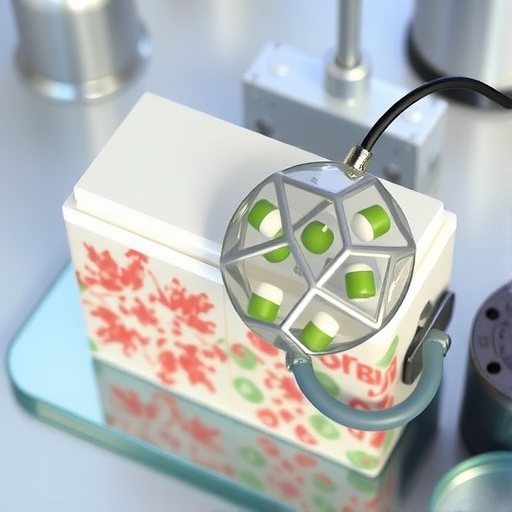In a groundbreaking study exploring the intricate relationships between bioenergy production and microbial communities, researchers have meticulously demonstrated how the surface modification of anodes in microbial fuel cells (MFCs) can dramatically influence performance metrics, particularly microbial diversity and chemical oxygen demand (COD) removal efficiencies. The innovative methodologies utilized in this research center around the application of reduced graphene oxide (rGO) and molybdenum (Mo) as functional enhancements to electrode surfaces. This novel combination not only amplifies MFC effectiveness but also paves the way for more sustainable energy solutions.
Microbial fuel cells, which capitalize on the metabolic activity of microorganisms to convert organic substrates into electrical energy, are emerging as a promising technology for renewable energy production. The underlying mechanisms involve the transfer of electrons via microbial electron transport chains that utilize an anode as an electron acceptor. This electrochemical activity is crucial and highlights the need for optimized anode materials. The choice of material can significantly impact not only the efficiency of electron transfer but also the varieties of microbial communities that can thrive in these systems.
In the recent study spearheaded by Akyazı et al., the authors explore the hypothesis that enhancing the anode surface with rGO and Mo can catalyze a more diverse and efficient microbial ecosystem. Reduced graphene oxide is recognized for its excellent electrical conductivity, large surface area, and favorable biocompatibility, making it an ideal candidate for the enhancement of anode surfaces in MFCs. Molybdenum, on the other hand, is well-known for its catalytic properties that can facilitate various microbial metabolic pathways.
By applying a strategic combination of rGO and Mo to the anode surfaces, the study recorded a noteworthy increase in microbial diversity. This was attributed to the ability of the enhanced surfaces to support a broader range of microbial taxa, which in turn, promotes more efficient biofilm formation. biofilms are essential in MFCs as they serve as biological catalysts, converting organic substrates into energy while being anchored to the anode. The diversity observed in microbial populations is critical for resilience and efficiency in energy production.
Moreover, the research findings explicitly demonstrate the enhanced COD removal efficiency when rGO and Mo are employed in anode surface modification. Chemical oxygen demand serves as a key indicator of water quality as it reflects the amount of organic matter present in a solution. The results suggested that the modified anodes facilitated better electron transfer mechanisms, resulting in more effective biodegradation processes of organic substrates.
An extension of this work is the potential for implementing these findings in real-world wastewater treatment applications, wherein MFCs can serve dual functions: energy generation and pollution mitigation. This dual functionality is imperative in the fight against environmental pollution while simultaneously addressing energy demands. The modifications discussed in this research could thus serve as a catalyst for unlocking the full potential of microbial fuel cells in sustainable ecosystems.
The methodological rigor applied during the experiments provides a solid foundation for future research in this domain. Techniques such as high-throughput sequencing were utilized to profile microbial communities, yielding insights into their functional potential. This advanced approach allows researchers to correlate microbial diversity with functional outcomes, thereby generating a wealth of data that could inform the design of more efficient MFC systems.
Additionally, the research team acknowledges the need for further experimentation to explore the long-term stability of the rGO and Mo modifications. One crucial aspect of any new technology in bioenergy is its operational longevity and reliability under varying environmental conditions. Future studies will no doubt aim to address these aspects, thus enhancing the feasibility of such innovations in the context of large-scale applications.
A significant aspect of the research highlights the importance of interdisciplinary collaboration in the field of environmental science and engineering. As technology continues to advance, integrating knowledge from diverse fields like materials science, microbiology, and environmental engineering can lead to revolutionary insights in sustainable technologies. This collaborative spirit will be paramount as society seeks to tackle emerging environmental challenges.
The implications for policy and infrastructure are profound. As urbanization increases and wastewater management becomes more crucial, the adoption of microbial fuel cells equipped with optimized anode materials could drastically change energy and water management practices. The study presents a compelling case for investment in research and development to further explore and validate these technologies within the framework of sustainable urban planning.
In conclusion, the investigation into the effects of anode surface modification using rGO and Mo marks a significant advancement in the understanding of microbial fuel cells and their operational potential. Akyazı et al. provide a carefully curated body of evidence that supports the strategy of utilizing advanced materials to cultivate robust microbial communities, essential for increasing the efficiency of MFCs. As we stand on the brink of a new era in renewable energy, studies such as this illuminate pathways to harness the power of microbes in addressing some of the most pressing environmental challenges of our time.
The potent combination of cutting-edge materials with innovative biological processes reveals a promising trajectory for future research that could lead to commercially viable microbial fuel cells. As scientists continue to peel back the layers of microbial interactions in engineered systems, the potential to redefine energy production methods becomes tantalizing close.
Harnessing the productive capabilities embedded within the microbial world could indeed transform our approach to energy sustainability and push forward the boundaries of environmental technology.
Subject of Research: Microbial fuel cells using anode surface modification with reduced graphene oxide and molybdenum.
Article Title: Anode surface modification with reduced graphene oxide (rGO) and molybdenum (Mo) enhances microbial diversity and chemical oxygen demand (COD) removal in microbial fuel cells.
Article References:
Akyazı, H., Güldür, F.Ç. & Beyzi, E. Anode surface modification with reduced graphene oxide (rGO) and molybdenum (Mo) enhances microbial diversity and chemical oxygen demand (COD) removal in microbial fuel cells.
Environ Sci Pollut Res (2025). https://doi.org/10.1007/s11356-025-37243-0
Image Credits: AI Generated
DOI: https://doi.org/10.1007/s11356-025-37243-0
Keywords: Microbial fuel cells, reduced graphene oxide, molybdenum, chemical oxygen demand, microbial diversity, sustainable energy.




